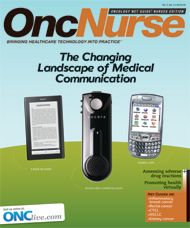Publication
Article
ONCNG Oncology Nursing
Can You Hear Me Now?
Despite major advances in communication technologies, numerous hospitals and clinics still use overhead paging, intercoms, Walkie Talkies, and other antiquated methods to reach staff members.
Despite major advances in communication technologies, numerous hospitals and clinics still use overhead paging, intercoms, Walkie Talkies, and other antiquated methods to reach staff members. We all remember—and some of us still encounter—the crackle of the intercom and the garbled messages that usually followed, and most of us can recall instances when people being paged said that they did not hear their pages, while patients and visitors said that they heard every one. To improve communication at Memorial Sloan- Kettering Cancer Center (MSKCC), which is spread out over a 13-block area of Manhattan, a hands-free wireless communications system called Vocera® was introduced. This system, which features a small lightweight communications device that is worn on a lanyard or clipped on clothing, was found to reduce noise, decrease duplicity in communication equipment, and improve efficiency. You can learn more about this technology and how it was implemented at MSKCC in Gay Bailey’s article “Implementation of a Hands-free Wireless Communications Device in a Comprehensive Cancer Center”.
In our second nurse-authored article, Neil McElligott refers to Epocrates®, the mobile provider of drug, disease, and laboratory information, as a “helping hand for nurses.” As he notes in his article, it’s not humanly possible to recall the correct dose or know the side effects and contraindications of all of the currently available medications. Tools such as Epocrates enable nurses to quickly and easily locate up-to-date, comprehensive medical information via their computers, smartphones, and other personal data devices. Epocrates now also features a drug module for over-the-counter medications, which is a huge time-saver for healthcare providers and a possible life-saver for patients.
The Internet contains a vast amount of information. As Roxanne Williams-Truax notes in her Clinical Trials Observations, the Food and Drug Administration and the National Cancer Institute (NCI) sites are invaluable resources for nurses caring for patients enrolled in clinical trials. The NCI site contains the latest version of the Common Toxicity Criteria, which was developed to provide a unified language for classifying and grading side effects and treatment- related toxicities. Using these criteria, we can all speak the same “language” to identify and document toxicities and adverse events.
As Dr Lisa Marie Bernardo reminds us in the Fitness Forum, the Internet provides around-the-clock access to information, and she describes how Web-based information and tools, such as activity logs, can promote behavior change. Another site that patients with cancer and their families may find useful is www.caringbridge. org, which provides free personalized Websites to people who are ill. The site allows guests to visit a patient’s Website to read journal updates and post messages. Caring Bridge provides a way for patients to communicate with many people at once, as opposed to having to respond to individual e-mail messages or phone calls.
It is interesting to see how communication and information technology has advanced in response to human needs, and the need for speed, up-to- date accurate information, and the ability to stay connected have all driven progress. It’s hard to imagine where things will go from here, but chances are that technologies will become even smaller, faster, and more immersive than they are now.
